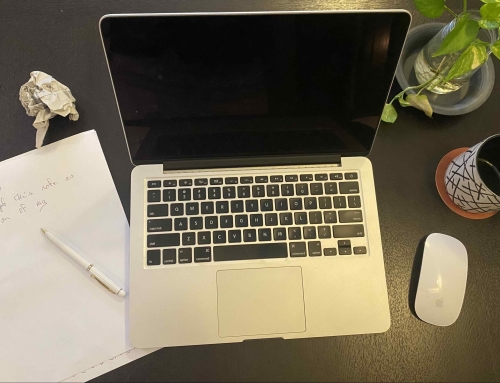There has always been something slightly scary about the deep and dark blue water of the open ocean. Looking over the side of a ship or going snorkelling at the edge of the reef for the first time. For a lot of people, the simple act of getting out in front of a crowd to speak can stir the same sort of feelings.
Welcome to the second blog in a series covering presentation skills for the rest of us, those of us who are not professional speakers. How many people actually like standing up there in front of an audience to make a speech, deliver a business review or just make an impromptu response when put on the spot at a gathering? In my last blog we looked at preparation. Here are some tips and basic guidelines to help make ‘getting out there’ less fearful and more manageable.
Firstly, begin with how you can make it easier for your audience to connect or communicate with you.

The very classical sleep inducing podium set up.^
Many of us have been to one of those industry events, or better still, a government agency event where the speaker has eyes down reading a prepared speech, (usually way too long), both hands fiercely gripping the large wooden lectern, head barely visible due to the oversized flower arrangement adorning it. I have, and many at that. They are hardly inspiring or engaging.
Good presenters get out there in front of the audience. They abandon the podium ‘life ring’ and enjoy splashing around in the free space of the stage. Just take a look at any Ted Talk and the vast majority of presenters will deliver their message this way, getting their cues from well placed monitors or an Auto-Cue. So remove the barriers might come between you and your audience. Why? Because lecterns, head tables, consoles or ‘Jim’s great idea for creative set decor’ could just get in the way. It pays to simplify or minimise the stage set up, if you have one.
And then there’s the lighting. Make sure you can actually be seen. Stand in the light. Why be there at all if your audience can’t see you in the gloom.
If you don’t have a budget, why not ask for a standing lamp or two for a folksy effect? If you have a budget, get soft lights focussed on the stage, but not ‘manned’ follow spot lights or you won’t be able to see your audience. If you are presenting in a small room, put the general lights on, move back a little from the audience and create a space in which to move and be seen.

The presenters Light Sabre
Secondly; Don’t ever turn your back on the audience.
Seriously. You should always maintain a forward view, keeping good eye contact with key member/s of the audience. The truth is, the minute you turn your back, you loose engagement, you become secondary to the material on the screen or the stage on which you are standing.
Next, don’t refer to the screen by looking at it. Ever. It can be an addictive safety blanket, but before you know it, you turn around and half the audience is looking at their Mobile Phones or has fallen asleep. Thats why you rehearse, have a floor monitor or well placed laptop to refer to. More about that later.

Quadrella: Back to audience, in the dark, behind the lectern and using laser pointer…
Another thing; leave the laser pointer to the Jedi Knight wannabes. It is better to use pre programmed highlights, fades, even animations which are built into your presentation. These will impress your audience and build your reputation as an innovator. Just compare this to the overwhelming number of amateur presenters addicted to, and never quite figuring out how to use, their ’00’s era gadgets. (More about fades and animations later)
Now you are getting hands free.
Number five; if you need a mic, try to get hold of a lapel mic. Two would be even better, one on each collar or lapel. It gives balance to the voice and there is no fading if you turn your head. If you have to use a hand held mic then hold it vertically, just in front of your chest and have the sound tech adjust the volume so it complements your voice.
If you are in a small room without a Mic, then try to stand near the corner, as it will amplify the sound. Yep, that’s right.

Where to begin? A lot wrong with this one including classic blue head syndrome.
If you still prefer to stand behind the podium with two ‘gooseneck’ microphones criss crossing your torso then try to add variety to your presentation. More about that in the next blogs.
And finally, if you have a large audience and are using a data projector: Get. Out. Of. The. Projector. Beam.
I call it blue head syndrome. The presenter is chatting away while last months financial figures are dancing all over his or her head. I mean really? How can that even be comfortable for the eyes?
To avoid this, I use masking tape. A little ‘X’ placed strategically on the floor to show roughly where you should stand so you don’t get blue head syndrome. Now if you are on a large stage, then think about marking out a couple of straight lines, in masking tape strips, that run the length of that borderline between stardom or the silliness of you stepping into the light of the screen image. Or you could use and LED wall.
Another way around this might be to avoid standing altogether.
Once you are confident, get down and comfortable. I sometimes like to present from a low chair next to a coffee table, with a series of guest presenters joining me on stage like some TV late show host. The coffee table gives you somewhere to place your laptop which can act as an auto cue. Why not? It adds variety if you have to do a lot of regular presentations… But that’s another story.
In the next instalment, Presentation Skills 3, I will talk about basic messaging, squashed faces and other maladies.
^Xi Jinping appears here without my permission.
*Suzy appears courtesy of Marco Polo Hotels.





